 |
 |
 |
| |
US Hepatitis C Burden Assessment from a Transmission Model: HCV burden reduced by new HCV drugs
|
| |
| |
44th EASL April 23-26 2009 Copenhagen
Reported by Jules Levin
H Zhang, M Mehra, J DiBello
Johnson & Johnson Pharmaceutical Services, LLC, Raritan, NJ, USA
Huabin Zhang, MD, MPH, Worldwide Health Economics and Pricing, Virology, Johnson & Johnson Pharmaceutical Services, LLC, 700 Raritan 202 South, Raritan, NJ 08869-0602, USA, E-mail: HZhang20@its.jnj.com
This analysis was carried out by Johnson & Johnson/Tibotec. Medical writing support was provided by Gardiner-Caldwell Communications and was co-funded by Tibotec and Vertex Pharmaceuticals.
AUTHOR CONCLUSIONS
Our model suggests that a regimen for treating CHC infection that could achieve a higher SVR than current therapy could have a substantial positive impact on public health in the USA.
This positive impact is primarily due to the projected reduced treatment-failure rate, reduced incidence of CHC infection, reduced number of patients progressing to ALD, and reduced HCV-related mortality.
Introduction
Less than half of all patients infected with hepatitis C virus (HCV) genotype 1, the predominant HCV genotype in the USA and Europe, achieve a sustained virological response (SVR) following treatment with peginterferon and ribavirin (Peg-IFN/RBV) for 48 weeks, the current standard treatment for chronic hepatitis C (CHC) infection.1-4
In patients who achieve SVR, HCV can be considered to be eradicated.5 This prevents the patient further transmitting the virus and potentially reduces CHC incidence.
In this epidemiological analysis, we attempt to estimate the future public health burden of CHC infection on the US adult population under the currently available treatment regimen (Peg-IFN/RBV) and assess the likely impact that a hypothetical, more effective new therapy (NEW) might have on these projections.
Methods
Compartment Model
· A multicompartment mathematical model (Figure 1) was developed to simulate the dynamics of HCV transmission and subsequent disease progression in the US population.
· The population model was expressed by partial differential equations across compartments based on CHC infection, diagnosis, treatment/retreatment status, SVR rates, progression to advanced liver disease (ALD), HCV genotype and injection-drug use.
· The patient population was divided into six different compartments: - Uninfected, susceptible- Infected, undiagnosed- Diagnosed, untreated- Treated- Treatment failed- ALD related to HCV infection (treated and untreated).
· Within each compartment patients were stratified for HCV genotype (genotype 1 and genotype 2/3) and history of injection-drug use (current hard drug users [HDU], prior HDU, and never HDU). Injection drug use was the most common risk factor (54%) for HCV infection in cases reported in 2006 where information concerning exposures during the incubation period was available:6
· At each model cycle, patients either remained in the same compartment, moved to another compartment according to the solid arrows, or died. The model was applied to patient groups defined by injection drug use category and genotype.
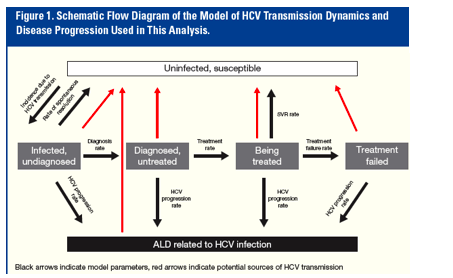
Key Assumptions in the Model
· Peg-IFN/RBV achieves a SVR of 45% in patients with HCV genotype 1 and 79% in patients with HCV genotype 2 or 3.
· The duration of Peg-IFN/RBV treatment is consistent with current treatment guidelines: 48 weeks for patients with HCV genotype 1, 24 weeks for patients with HCV genotype 2 and 3, and 12 weeks for patients who met stopping guidelines.7
· NEW becomes available in 2011 for previously untreated patients with HCV genotype 1 and achieves a 25% improved incremental SVR rate compared with Peg-IFN/RBV (70 vs 45%, respectively); the treatment rate is assumed to be the same as 2006.
· From 2011, all patients with Peg-IFN/RBV treatment failure are retreated with NEW with a treatment rate of 50%, and achieve a 50% SVR rate.
· Patients with NEW treatment failure are not retreated with NEW.
· The model assumes all progression rates are equal. There is not sufficient evidence to suggest diagnosis/treatment rate affects progression rate.
· NEW is not used to treat patients with HCV genotype 2 or 3.
· Transmission, diagnosis and treatment rates remain unchanged.
Model Inputs
· The initial model inputs were based on published epidemiological data (Table 1).
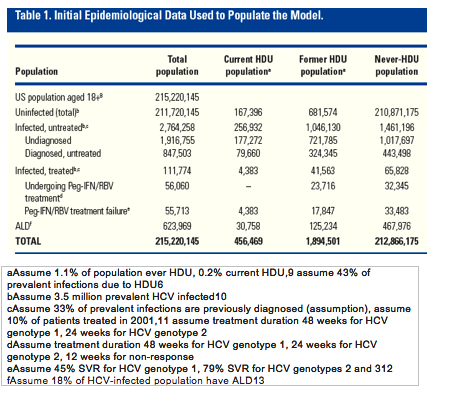
Model Calibration
· To ensure sensitivity and reliability, the model was calibrated with values from 2002 to 2006:- Model calibration consists of changing values of model input parameters in an attempt to match 'real-life' conditions within acceptable criteria.
· All input values and modelled values for 2002 to 2006 closely matched Centers for Disease Control reports and other published epidemiological data (Table 2, Figure 2).
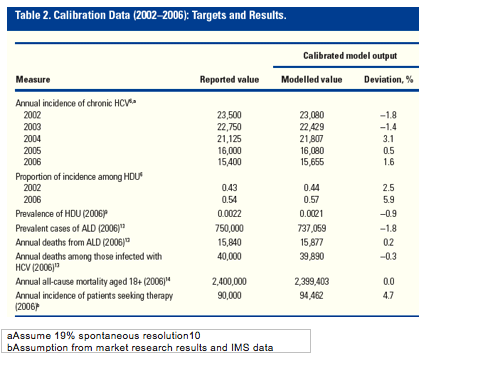
Model Projections
· The calibrated model was then applied to assess the public health burden of CHC from 2007 to 2040 under the current Peg-IFN/RBV treatment strategy. The potential benefits of introducing NEW were also assessed.
· Key outcomes of interest were:- Prevalence and annual incidence of HCV infection- Prevalence and annual incidence of HCV-associated ALD- HCV transmission and diagnosis rates- Cumulative incidences of treated and cured patients, HCV infection, HCV-associated ALD and overall mortality.
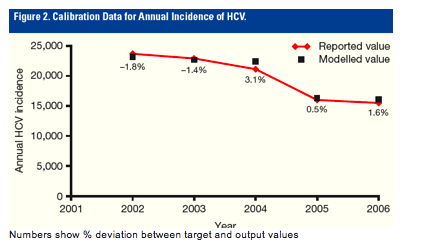
Model Programming
· The model was programmed in Microsoft Excel using the Visual Basic for Applications (VBA) package. Because the techniques developed to solve differential equations in Excel provide an approximation to the exact solution, the model was validated by comparing its results to those generated by a differential equation solver, Berkeley Madonna (www.berkeleymadonna.com).
RESULTS
Estimation of Model Parameters
In the calibrated model, the HCV transmission and diagnosis rates were estimated to be:
-- 2.45x10-7 and 15%, respectively, among HDU
- 2.22x10-11 and 10%, respectively, among former HDU and those who had never used injection drugs.
The estimated treatment rate is 6% among existing diagnosed patients and 30% among newly diagnosed patients.
Model Projections
· Under the current Peg-IFN/RBV regimen, the prevalence of CHC infection in the USA was projected to be around 1.72 million at 2040 (Figure 3). This estimate includes approximately:
-- 80,000 undiagnosed patients
-- 198,000 diagnosed, but never-treated patients
- 609,000 patients with Peg-IFN/RBV treatment failure
-- 825,000 patients with HCV-associated ALD
- 8,000 Peg-IFN/RBV-treated patients.
In contrast, when NEW was used, the prevalence of CHC was projected to be approximately 1.38 million at 2040, approximately 335,000 (19%) fewer cases than if only Peg-IFN/RBV were used (Figure 3). This is mainly as a result of fewer treatment failures and fewer patients progressing to ALD. This estimate includes approximately:
- 73,000 undiagnosed patients (approximately 7,000 [9%] fewer than underPeg-IFN/RBV)
-- 194,000 diagnosed, but never-treated patients (approximately 4,000 [2%] fewer)
- 362,000 patients with treatment failure (approximately 247,000 [41%] fewer)
- 747,000 patients with HCV-associated ALD (approximately 78,000 [9%] fewer)
- 9,000 patients treated with Peg-IFN/RBV and NEW (approximately 1,500 (20%) more)
-- Note that, due to rounding, these approximate figures do not total 1.38 million.
· Likewise, under the Peg-IFN/RBV regimen, the prevalence of ALD in HCV-infected patients was projected to be around 825,000 at 2040. With the use of the NEW regimen, the prevalence of ALD was projected to be approximately 78,000 cases (9%) lower (Figure 4).
· The model predicted that following the introduction of NEW, 206,572 more patients would be treated for CHC infection between 2011 and 2040 versus the use of Peg-IFN/RBV alone (Table 3).
· Between 2011 and 2040, it was projected that the use of NEW versus Peg-IFN/RBV would lead to (Table 3):
- 351,448 (56%) more patients cured (as defined by the achievement of SVR)
- 23,444 (7%) fewer cases of CHC
- 103,953 (18%) fewer cases of ALD due to CHC
- 39,929 (5%) fewer deaths due to CHC.
· However, 7,361 (1%) fewer treatment-naÏve patients would actually be treated with NEW (1,096,808) following its introduction compared with Peg-IFN/RBV alone (1,104,169). Conversely, 342,346 more patients with prior treatment-failure would be treated under NEW (342,346) compared with Peg-IFN/RBV (0).
Model Limitations
· The usual limitations of disease models, which are necessarily simplifications of the disease and treatment process, apply to this model. Results are highly dependent on model assumptions and inputs.
· There are two additional limitations specific to this model:
- Lack of precision of the reported values used for calibration. Many persons infected with HCV have non-specific symptoms or are asymptomatic and there is little systematic screening for HCV. Estimates of even the most fundamental epidemiological characteristics such as incidence and prevalence are therefore imprecise.
- The model tracks patients' development of ALD but does not explicitly incorporate the stages of disease progression, liver cancer and liver transplantation. A more complete model would allow a better estimation on the potential benefits of improved management of HCV.
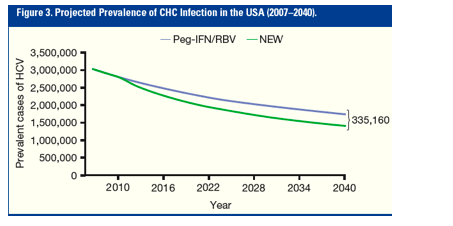
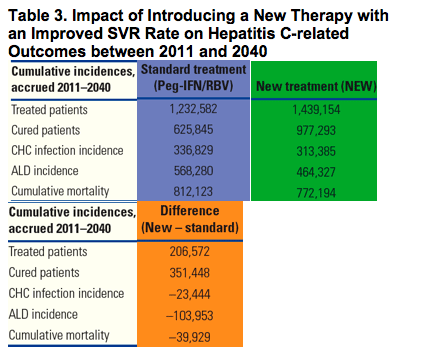
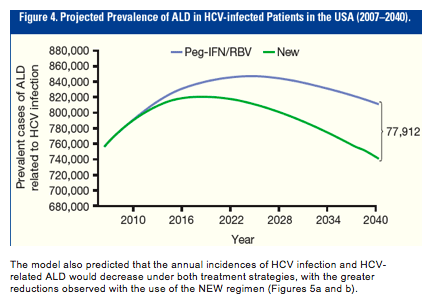
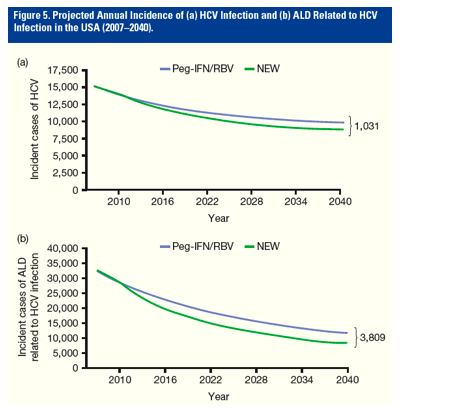
REFERENCES
1. Manns MP, et al. Lancet 2001;358:958-65.
2. Fried MW, et al. N Engl J Med 2002;347:975-82.
3. Bini EJ, et al. Am J Gastroenterol 2005;100:1772-79.
4. Nainan OV, et al. Gastroenterol 2006;131:478-84.
5. Maylin S, et al. Gastroenterol 2008;135:821-9.
6. Wasley A, et al. MMWR Surveill Summ 2008;57:1-24.
7. Strader DB, et al. Hepatol 2004;39:1147-71.
8. US Census Bureau, Census 2002.
9. Armstrong GL. Arch Intern Med 2007;167:166-73.
10. Armstrong GL, et al. Ann Intern Med 2006;144:705-14.
11. Butt AA, et al. Aliment Pharmacol Ther 2006;24:585-91.
12. Castelnuove E, et al. Health Technol Assess 2006;10:1-112.
13. Davis GL, et al. Liver Transpl 2003;9:331-8.
14. Heron MP, et al. Natl Vital Stat Rep June 11 2008;56:1-52.
|
| |
|
 |
 |
|
|